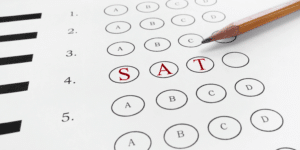Does it really matter when you take the SAT or ACT? If you want to get into college, you might want to check out these three strategies to give yourself a scheduling advantage.
***
Determining when it’s best to take the SAT or ACT really comes down to when you’ll have time to prepare and to properly organize your junior and senior year priorities.
First, it’s important to give yourself an opportunity to take the test two to three times. Many students underperform the first time they take the test, and if you’re prone to test anxiety, knowing that you have only one chance to do well will make that anxiety even worse.
Furthermore, most schools “superscore” the SAT, and a growing number superscore the ACT. Superscoring means that schools will mix and match results from multiple test dates to give you the best overall score. So, for example, if you scored 640 Math and 550 Reading on one SAT and then scored 560 Math and 660 Reading on the next, your superscore would be 640 Math and 660 Reading—that’s the score most schools would use when weighing your application.
The next factor to take into account is the Early Decision/Early Action deadline. Ideally, you want to give yourself the option to apply early to one or more schools.
Finally, if you are taking SAT Subject Tests, you have to make sure you have time to fit those in as well. This is especially complicated if you are taking the SAT, since Subject Tests and the SAT are offered on the same test dates.
With all these factors in mind, there are three major timing models for preparation.
Model 1: Heavy Preparation Summer Before Junior Year, First Test in the Fall.
A lot of students have substantial free time during the summer, and this model takes advantage of that free time. You prepare heavily during the summer, then take your first test in the fall of your junior year. This gives you plenty of chances for second and third test dates, and has the added bonus of potentially getting the test out of the way before the second semester of your junior year, a very important time for your transcript/grades.
The downside of this model is that you’ll be taking the test without the benefits of everything you’ll learn Junior year; odds are that your math and especially your reading skills will get stronger over the course of that year, possibly enabling you to score higher if you put off the test.
Model 2: Start Preparation as the School Year Begins, First Test Winter or Early Spring
This is the model used by students who are planning ahead, but who are busy during the summer. They start preparing at the end of the summer and take their first test when they’re ready: as early as December and as late as March, depending on the student. This plan still make it’s easy to take the test multiple times, but it does tend to make for a more packed school year.
Model 3: Start Preparation After Winter Break, First Test in Spring
This model more or less guarantees you’ll have a time crunch second semester of junior year, especially if you’re also taking AP’s and/or Subject Tests. That said, it’s still a viable model, especially for students who don’t need a lot of improvement from their baseline test scores. You may have to schedule your second test in the fall, which can create a real crunch if you have to take Subject Tests then too. Overall, this is a recipe for a hectic schedule, so if this is the route you plan to take, understand there’s a very good chance you’ll still be testing fall of your Senior year.
Finding Your Path
The bottom line is that you need to strike the proper balance between your other priorities and these standardized tests and find the best time to prepare. I generally recommend one of the first two models, as they don’t put the student under as much pressure as the third, but I’ve seen students succeed using any of these approaches.
If you can manage the first model—prep during the summer and first crack at the test before Winter Break—I think that’s the best approach to take for students who don’t need the benefit of their Junior year courses in order to score well.
Related Topics:
15 Great Test-Optional Colleges You Should Consider
5 Ways International Students Can Prepare For The New SAT English Section




